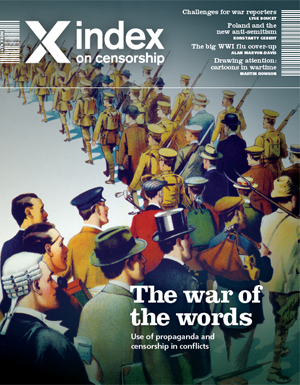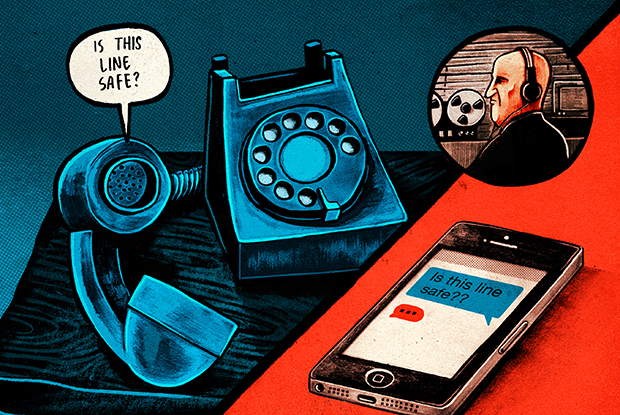24 Nov 2015 | News and features, Press Releases, United Kingdom
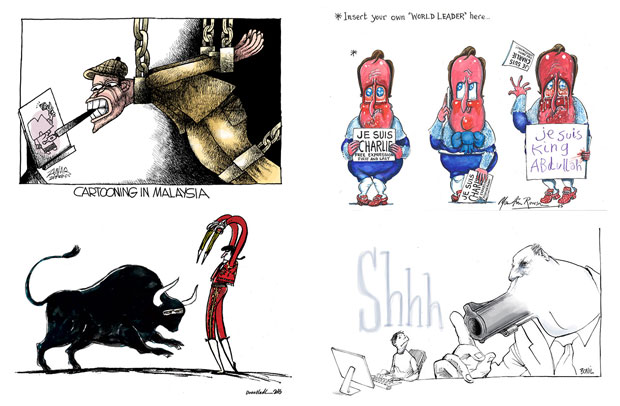
Among the cartoons available in the auction are original artworks by Zulkiflee Anwar Haque (Zunar); Martin Rowson; Xavier Bonilla (Bonil); and Doaa El Adl (clockwise from top left).
Index on Censorship is delighted to announce the auction of an incredible collection of cartoons that celebrate the power of art to challenge suppression. The auction will help fund our work supporting persecuted writers and artists worldwide.
Make a new donation to Index before the end of December to receive a limited-edition postcard set of 10 cartoons created by some of the world’s top political cartoonists
Earlier this year, Index commissioned 10 of the world’s leading cartoonists to pen a work on the theme of free expression. The cartoons are powerful tributes to the role of art, drawn by world-renowned artists from every continent: from a US Pulitzer Prize winner to a Syrian cartoonist beaten in retaliation for his work.
Beginning Tuesday, 24 November 2015, bidders will be able to enter bids for hand-drawn artwork by:
Xavier Bonilla (Bonil) – Ecuador
Regularly denounced, threatened and fined, Ecuador’s Bonil has earned the title “the pursued cartoonist” for his work. For 30 years he has critiqued, lampooned and ruffled the feathers of Ecuador’s political leaders, in the process earning a reputation as one of the wittiest and most fearless cartoonists in South America.
Kevin Kallaugher (Kal) – United States
US artist Kal is the editorial cartoonist for The Economist and The Baltimore Sun and his work has appeared in more than 100 publications worldwide including Le Monde, Der Spiegel, The International Herald Tribune, The New York Times, Time, Newsweek, and The Washington Post. He has won numerous awards, including the 2014 Grand Prix for Cartoon of the Year.
Signe Wilkinson (Signe) – United States
The first woman to win the Pulitzer Prize for Editorial Cartooning, Signe has won several other awards for her work. She comments on topical political issues and is best known for her daily cartoons in The Philadelphia Daily News.
Jean Plantureux (Plantu) – France
Plantu is the chief cartoonist for France’s Le Monde and founder of Cartooning for Peace, a global network of cartoonists. This drawing is a rare, signed copy of the world-famous cartoon Plantu drew for Le Monde the day after the attack on Charlie Hebdo.
Martin Rowson – UK
A former Cartoonist Laureate, political satirist Martin Rowson contributes cartoons to The Guardian and the Daily Mirror as well as Index on Censorship magazine. His work has earned him several awards, including the prize for the Best Humour and Satire Book of the Year at this year’s Political Book Awards.
Ali Farzat – Syria
Ali Farzat, a former Index on Censorship Freedom of Expression Award winner, came to global attention in 2011 when he was pulled from his car and beaten by Syrian security forces who broke both his hands. When Kuwaiti authorities closed the offices of his newspaper, Al-Watan, earlier this year Ferzat was forced to buy new materials and redrew this cartoon for us from scratch.
Doaa El Adl (Doaa) – Egypt
Doaa is a celebrated female artist in the Arab world – well know for her fearless political work. She has often tackled freedom of speech, human rights and women’s rights issues, wining numerous awards as well as controversy and even charges of blasphemy for her work.
Zulkiflee Anwar Haque (Zunar) – Malaysia
Zunar is an award-winning Malaysian political cartoonist who has been repeatedly targeted by authorities. Five of his cartoon books have been banned by the Malaysian government for carrying content “detrimental to public order” and thousands confiscated. He is currently facing up to 43 years in jail for mocking the government.
David Rowe – Australia
A three-time winner of the Stanley Award for Australia’s Cartoonist of the Year, David Rowe has worked for the Australian Financial Review for 22 years. Rowe’s bright and colourful watercolours are famously merciless.
Damien Glez – (Glez) – Burkina Faso
Glez’s cartoons regularly appear across three continents, including his own weekly satirical newspaper in Burkina Faso: Le Journal du Jeudi . He co-created pan-African monthly satirical Le Marabout, writes his own comic strip Divine Comedy and has won numerous awards internationally..
Bids must be placed by noon on Monday, 14 December 2015.
The auction is being hosted by Givergy.
16 Sep 2015 | Magazine
In conjunction with the Cambridge Festival of Ideas 2015, we will be publishing a series of articles that complement many of the upcoming debates and discussions. We are offering these articles from Index on Censorship magazine for free (normally they are held within our paid-for archive) as part of our partnership with the festival. Below is an article by cartoonist and author Martin Rowson, who regularly draws for the magazine, on the power of propaganda in wartime, taken from the spring 2014 issue. It’s a great starting point for those who plan to attend the War, Censorship and Propaganda: Does It Work session at the festival this year.
Index on Censorship is a global quarterly magazine with reporters and contributing editors around the world. Founded in 1972, it promotes and defends the right to freedom of expression.
As a political cartoonist, whenever I’m criticised for my work being unrelentingly negative, I usually point my accusers towards several eternal truths.
One is that cartoons, along with all other jokes, are by their nature knocking copy. It’s the negativity that makes them funny, because, at the heart of things, funny is how we cope with the bad – or negative – stuff.
Whether it’s laughing at shit, death or the misfortunes of others, without this hard-wired evolutionary survival mechanism that allows us to laugh at the awfulness running in parallel with being both alive and human, apes with brains the size of ours would go insane with existential terror as soon as the full implications of existence sink in. Which, for most people, would be when you’re around three years old.
And if that doesn’t persuade them, I usually then try to describe that indescribable but palpable transubstantiation that occurs when you shift from the negative to the positive, and a cartoon sinks from being satire to becoming propaganda.
Though here, of course, I’m not being entirely honest, because in many ways cartoons are propaganda in its purest form. This is because the methodology of the political cartoon has most in common with the practices of sympathetic magic and, likewise, its purposes are invariably malevolent.
Indeed, I’ve often described caricature in particular and political cartooning more generally as a type of voodoo, doing damage at a distance with a sharp object, in this case (usually) a pen.
Certainly the business of caricature is a kind of shamanist shape-shifting, distorting the appearance of the victim in order to bring them under the control of the cartoonist and subjecting them thereafter to ridicule or opprobrium. In short, political cartoons should truly be classified not as comedy but as visual taunts. And taunts, of course, have been an integral ingredient of warfare for millennia.
Within the twisted plaiting of taunts, posturing and brinkmanship that ultimately ended in the hecatombs of the Western Front in World War I you can just about tease out one thread trailing back to a cartoon.
The original sketch for the allegorical 1896 cartoon Nations of Europe: Join in Defence of Your Faith! was by Kaiser Wilhelm II of Germany, though he left the job of the finished artwork to professionals. Its purpose was to stiffen the resolve of European leaders against the “yellow peril” coming from east Asia, and to this end the Kaiser presented a copy of the cartoon to his cousin Tsar Nicholas II of Russia.
It’s generally agreed that the cartoon played a small but significant part in influencing the Tsar’s confrontational policy towards Japan, which ended in Russia’s humiliating defeat in the 1904-05 Russo-Japanese war.
The subsequent revolutions, regional wars and growing European instability erupted nine years later with the general mobilisation of the Great Powers, and the cartoonists were mobilised along with everyone else.
Although a perennial taunt against the Germans is that they have no sense of humour, they had as rich a tradition of visual satire as anyone else. In the pages of both Punch and the German satirical paper Simplicissimus, the enemy was caricatured identically as alternatively preposterous and terrifying. Both sides showed the other in league with skeletal personifications of Death, or transformed into fat clowns, foul or dangerous animals or, in British cartoons about Germans, as sausages.
There were also scores of cartoons showing German soldiers bayoneting Belgian babies in portrayals of “The Beastly Hun” and, later, cartoons showing the Germans harvesting the corpses of slain soldiers for fats to advance their war effort.
All sides taunted each other by attacking their nations’ supposed leaders, using the caricaturist’s typical tools. Thus the Kaiser, mostly thanks to his waxed moustache, acted as a synecdoche for Germany’s defining perfidy. In one cartoon from 1915, when Britain’s George V stripped his cousin, the Kaiser, of his Order of the Garter, his garterless stocking slips down, revealing a black and hairy simian leg. In 1914, meanwhile, the German cartoonist Arthur Johnson (his father was an American) showed the British Royal Family, German by descent, in a camp for enemy aliens.
These taunting cartoons bore little relation to the realities of modern warfare, and most of them would now be dismissed purely as rather ham-fisted propaganda. This shouldn’t downplay their effectiveness, however.
A century earlier Napoleon Bonaparte admitted he feared the damage done by James Gillray’s caricatures of him more than he feared any general, because Gillray always drew him as very short. (To bring this up to date, Le Monde’s cartoonist Plantu told me that every time he drew Nicolas Sarkozy as short, Sarkozy complained personally to his editor; the next cartoon would make him even shorter, and Sarkozy would complain again, until in the end Plantu drew the French president as just a head and feet.)
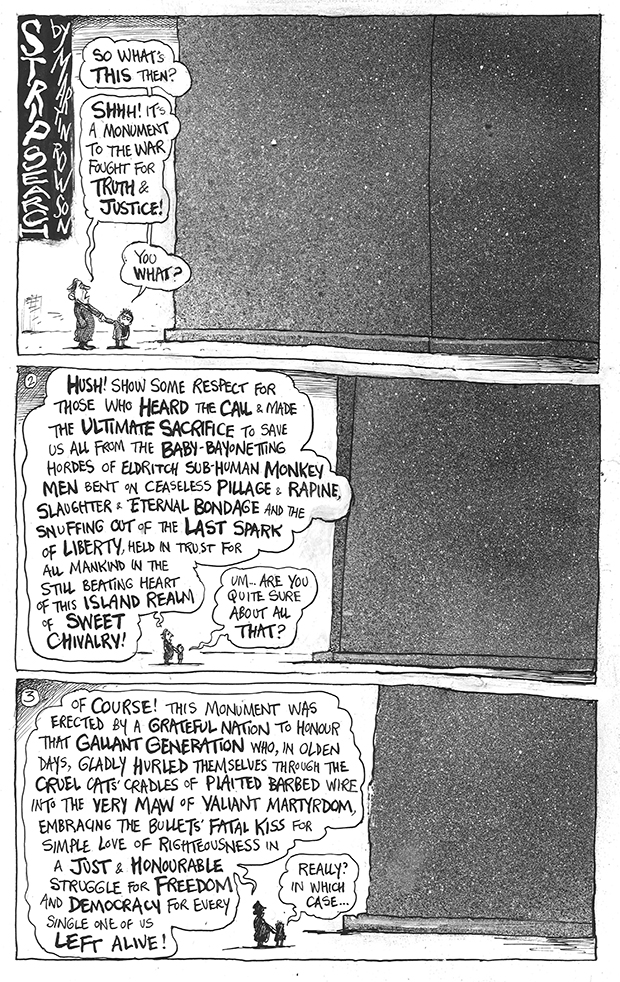
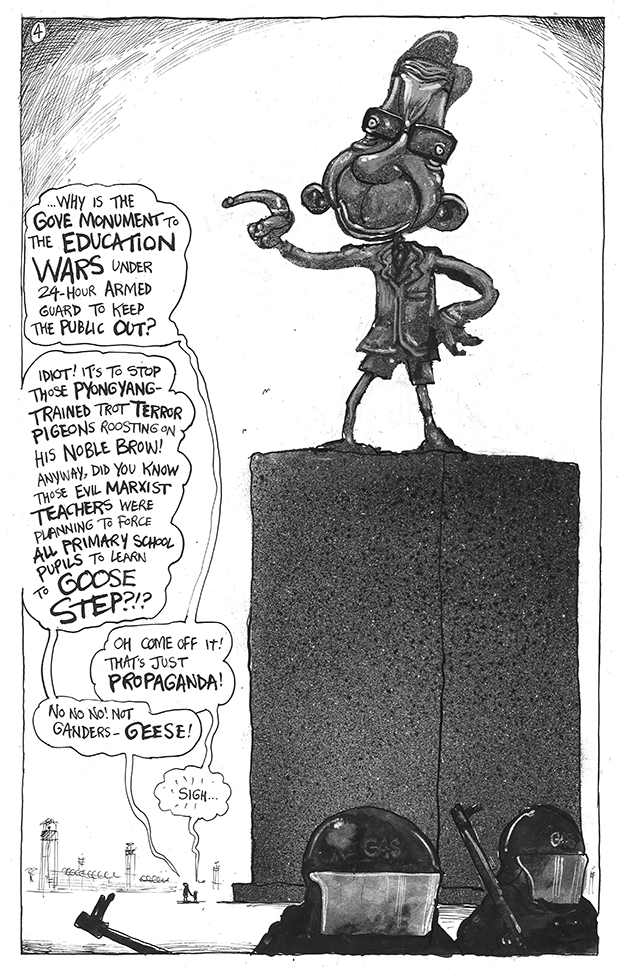
Nonetheless, an unforeseen consequence of this barrage of caricature was that in the end people stopped believing it to be anything more than merely caricature: the truth that should be exposed by the exaggeration got lost. In the 1930s, many people assumed reports of the genuine atrocities of the Nazis were, like the bayoneted babies or harvested corpses blamed on the Kaiser, just propaganda.
Posterity shouldn’t concern cartoonists. We’re just journalists responding to events with a raw immediacy. This is what gives the medium a great deal of its heft.
Some cartoons, however, encapsulate a time or an event and so become part of the more general visual language. Gillray’s The Plum Pudding in Danger is a perfect example, depicting the specific geopolitical struggle between William Pitt and Napoleon in 1805, while also capturing eternal truths about geopolitics itself. But I’m not aware of any political cartoons from World War I that do the same thing.
And yet the medium operates in many ways, and the most effective and popular cartoonist of World War I was undoubtedly Bruce Bainsfather, a serving artillery officer who drew gag cartoons about the slapstick of everyday life in the trenches in his series featuring “Old Bill”. The serving soldiers loved these cartoons, and they are another instance of humour being used to make the harshest imaginable reality simply bearable.
The other truly great cartoon to emerge from the World War I was published after it was all over. In his extraordinarily prophetic drawing Peace and Future Cannon Fodder for the Daily Herald, Will Dyson showed the Allied victors of the war exiting the Versailles peace conference and the French prime minister Georges Clemenceau saying: “Curious! I seem to hear a child weeping.” Behind a pillar a naked infant labelled “1940 class” is crying into its folded arms.
None of the protagonists in the next war doubted the power or importance of cartoons. Again, they were used by all sides to taunt and vilify their foes, perhaps most notoriously in Der Sturmer, the notorious anti-semitic paper edited by Julius Streicher, later hanged at Nuremburg.
Simplicissimus was, once more, taunting the British, this time drawing wartime prime minister, Winston Churchill, as a fat and murderous drunk; in the Soviet Union Stalin’s favourite cartoonist, Boris Yefimov, returned the compliment to the Nazi leadership (Yefimov’s older brother Mikhail first employed him on Pravda before being purged and executed in 1940; Boris survived him by 68 years, dying aged 108 in 2008). No cartoonist in either country would have dared caricature their own totalitarian politicians, but they were given full rein to exercise their skills on their nation’s enemies. In Britain, with its largely legally tolerated history of visual satire going back to 1695, things were slightly different, though also sometimes the same.
The New Zealand-born cartoonist David Low discovered in 1930 from a friend that Hitler, three years away from taking power in Germany, was an admirer of his work. Low did what any other cartoonist would do in similar circumstances and acknowledged his famous fan by sending him a signed piece of original artwork, inscribed “From one artist to another”.
It’s unknown what happened to the cartoon – maybe it was with him right to the end, in the bunker – but it soon became apparent that Hitler had mistaken Low’s attacks on democratic politicians for attacks on democracy itself. He was soon disabused. Low harried the Nazis all the way from the simple slapstick of The Difficulty of Shaking Hands with Gods of November 1933 to the bitterness of his iconic cartoon Rendezvous in September 1939, so much so that in 1936 British Foreign Secretary Lord Halifax, after a weekend’s shooting at Hermann Goering’s Bavarian hunting lodge, told Low’s proprietor at the Evening Standard, Lord Beaverbrook, to get the cartoonist to ease up as his work was seriously damaging good Anglo-German relations. Low responded by producing a composite cartoon dictator called “Muzzler”.
The Nazis had a point that Low entirely understood, and it was why he, along with many other cartoonists – Victor “Vicky” Weisz, Leslie Illingworth and even William Heath Robinson – were all on the Gestapo’s death list. In a debate on British government propaganda in 1943, a Tory MP said Low’s cartoon were worth all the official propaganda put together because Low portrayed the Nazis as “bloody fools”. Low himself later expanded on the point, comparing his work, which undermined the Nazis through mockery, with the work of pre-war Danish cartoonists who unanimously drew them as terrifying monsters. Low’s point was that it’s much easier to imagine you can beat a fool than a monster, and taunting your enemies as being unvanguishably frightening is no taunt at all.
The enduring efficacy of cartoons’ dark and magical voodoo powers were acknowledged in victory, when both Low and Yefimov were official court cartoonists at the Nuremburg war crimes tribunals (Low claimed Goering tried to outstare him from the dock): now the taunting was part of the humiliation served up with the revenge. Likewise, when Mussolini was executed by Italian partisans, the editor of the Evening Standard, Michael Foot, marked the dictator’s demise by giving over all eight pages of the paper to Low’s cartoons of Mussolini’s life and career.
Of course Low, unlike Yefimov, was actively hostile on the Home Front as well, producing cartoons critical of both the military establishment and Churchill. When Low’s famous creation Colonel Blimp, the portly cartoon manifestation of boneheaded reactionary thinking, took on fresh life in the Powell and Pressburger movie The Life and Death of Colonel Blimp, Churchill tried to have the film banned. When the Daily Mirror’s cartoonist Philip Zec responded to stories about wartime profiteering by contrasting them with attacks on merchant shipping in his famous cartoon The Price of Petrol has Been Increased by One Penny – Official, both Churchill and Home Secretary Herbert Morrison seriously considered shutting down the newspaper. (When the Guardian cartoonist Les Gibbard pastiched Zec’s cartoon during the Falklands war 40 years later, the Sun called for him to be tried for treason.)
And yet cartoons, for all their voodoo power, can still spiral off into all sorts of different ambiguities thanks to the way they inhabit different spheres of intent. Are they there to make us laugh, or to destroy them? Or both?
Ronald Searle drew his experiences while he was a prisoner of war of the Japanese, certainly on pain of death had the drawings been discovered, but taking the risk in order to stand witness to his captors’ crimes. Just a few years later, many of his famous St Trinian’s cartoons don’t just deal with the same topics – cruelty and beheadings – but share identical composition with his prisoner of war drawings.
And when Carl Giles, creator of the famous cartoon family that mapped and reflected post-war British suburban life weekly in the Sunday Express, was present as an official war correspondent at the liberation of the Bergen-Belsen concentration camp, the camp’s commandant, Josef Kramer, revealed he was a huge fan of Giles’ work and gave him his pistol, a ceremonial dagger and his Nazi armband in exchange for the promise that Giles would send him a signed original. As Giles explained later, he failed to keep his part of the bargain because by the time he got demobbed Kramer had been hanged for crimes against humanity.
Those twinned qualities of taunting and laughter go some way to explaining the experience of cartoonists in the so-called war on terror, if not the power of their work. In the aftermath of 9/11, in the Babel of journalistic responses to what was without question the most visual event in human history, then visually re-repeated by the media that had initially reported it, the cartoonists were the ones who got it in the neck. While columnists wrote millions of words of comment and speculation, and images captured by machines were broadcast and published almost ceaselessly, the images produced via a human consciousness were, it seems, too much to stomach for many. Cartoonists had their work spiked, or were told to cover another story (there were no other stories). In the US some cartoonists had their copy moved to other parts of the paper, or were laid off. One or two even got a knock on the door in the middle of the night from the Feds under the provisions of the Patriot Act.
Despite a concerted effort by some American strip cartoonists to close ranks on Thanksgiving Day 2001 and show some patriotic backbone, the example of Beetle Bailey flying on the back of an American Eagle didn’t really act as a general unifier. Unlike in previous wars, there was no unanimity of purpose among cartoonists. An editorial in The Daily Telegraph accused me, along with Dave Brown of The Independent and The Guardian’s Steve Bell, of being “useful idiots” aiding the terrorist cause due to our failure to fall in line.
The war on terror and its Iraqi sideshow were anything but consensus wars, and many cartoonists articulated very loudly their misgivings. These included Peter Brookes of the Murdoch-owned Times drawing cartoons in direct opposition to his paper’s editorial line. This has always been one of visual satire’s greatest strengths: sometimes a cartoon can undermine itself.
Moreover, because a majority of cartoons were back in their comfort zone of oppositionism, the taunting had less of the whiff of propaganda about it. Nor was there ever any suggestion in Britain of government censorship of any of this.
That said, the volume of censuring increased exponentially, thanks entirely to the separate but simultaneous growth in digital communication and social media. Whereas, previously, cartoons might elicit an outraged letter to an editor – let alone a death threat from the Gestapo – the internet allowed a global audience to see material to which thousands of people responded, thanks to email, with concerted deluges of hate email and regular death threats. I long since learned to dismiss an email death threat as meaningless – a real one requires the commitment of finding my address, a stamp and possibly a body part of one of my loved ones – but it’s the thought that counts.
More to the point was the second front in the culture-struggle at the heart of the war on terror, in which both sides fought to take greater offence. Amid the bombs, bullets and piles of corpses across Iraq, Afghanistan, Bali, Madrid, London and all the other places, the greatest harm you could suffer, it seemed was that you might be “offended”. People sent me hate emails and threatened to kill me and my children because they were “offended” by my depiction of George Bush, or by a cartoon criticising Israel, or a stupid humourous drawing of anything that might mildly upset them or their beliefs.
It was into this atmosphere that the row over the cartoons of Mohammed published by the Danish newspaper Jyllands Posten erupted, resulting in the deaths of at least 100 people (none of them cartoonists, but most of them Muslims, and many shot dead by Muslim soldiers or policemen). But that, of course, is another story. And – who knows? – may yet prove to be another war.
Martin Rowson’s cartoons appear regularly in The Guardian and Index on Censorship. His books include The Dog Allusion, Giving Offence and Fuck: the Human Odyssey.
© Martin Rowson and Index on Censorship
Join us on 25 October at the Cambridge Festival of Ideas 2015 for Question Everything an unconventional, unwieldy and disruptive day of talks, art and ideas featuring a broad range of speakers drawn from popular culture, the arts and academia. Moderated by Index on Censorship CEO Jodie Ginsberg.
This article is part of the spring 2014 issue of the global quarterly Index on Censorship magazine, with a special report on propaganda and war. Click here to subscribe to the magazine.
2 Sep 2015 | Academic Freedom, Magazine, mobile, Student Reading Lists
To tie in with the release of Index on Censorship magazine’s summer 2015 issue on academic freedom, Index put together a reading list of articles looking at the issues surrounding freedom of speech in universities from all over the world. Highlights include Kaya Genc’s examination of the Turkish universities that are restricting professors’ rights to teaching certain portions of history and Duncan Tucker’s look at the academics and students facing death threats in Mexico. There are also testimonies from young women who faced obstacles to getting an education.
All of these articles are taken from the special report of the summer 2015 issue of Index on Censorship magazine.
Students and academics can browse the Index magazine archive in thousands of university libraries via Sage Journals.
Academic freedom articles
Silence on campus: How a Turkish historian got death threats for writing an exam question by Kaya Genç
Kaya Genç, June 2015; vol. 44, 2: pp. 10-13
Index’s Turkish contributing editor discusses threats against professors that refuse to stick to the syllabus in Turkish universities
Universities under fire in Ukraine’s war by Tatyana Malyarenko
Tatyana Malyarenko, June 2015; vol. 44, 2: pp. 14-17
Academic’s jobs are under threat in Ukraine, Tatyana Malarenko discusses how many academics are being hauled in front of special committees and accused of terrorist activity
Industrious academics by Michael Foley
Michael Foley, June 2015; vol. 44, 2: pp. 18-19
Lecturer Michael Foley on the commercial pressures being applied to universities in Ireland
Stifling freedom: One hundred years of attacks on US academic freedom by Mark Frary
Mark Frary, June 2015; vol. 44, 2: pp. 20-25
Mark Frary takes us through one hundred years of attacks on freedom of expression in US universities
Stripsearch by Martin Rowson
Martin Rowson, June 2015; vol. 44, 2: pp. 26-27
Cartoonist Martin Rowson’s regular Index illustration looks at students being gagged at graduation
Ideas under review by Suhrith Parthasarathy
Suhrith Parthasarathy, June 2015; vol. 44, 2: pp. 28-30
In India, the autonomy of universities is being challenged by Prime Minister Narendra Modi amidst growing concerns of censorship
Girls standing up for education by Natumanya Sarah, Ijeoma Idika-Chima, and Sajiha Batool
Natumanya Sarah, Ijeoma Idika-Chima, and Sajiha Batool, June 2015; vol. 44, 2: pp. 31-33
Three female students from Uganda, Nigeria and Pakistan discuss their experiences of their own education systems
Open-door policy? by Thomas Docherty
Thomas Docherty, June 2015; vol. 44, 2: pp. 34-39
Government suppression of UK universities is becoming more and more of an issue, reports Thomas Docherty. Includes the students view by the editor of The Cambridge Tab Sarah Ivers.
Mexican stand-off by Duncan Tucker
Duncan Tucker, June 2015; vol. 44, 2: pp. 40-43
Journalist Duncan Tucker lays out the battle for academic freedom in Mexico, where death threats, harassment and beatings are commonplace in universities
Return of the Red Guards by Jemimah Steinfeld
Jemimah Steinfeld, June 2015; vol. 44, 2: pp. 44-49
Index’s contributing editor in China Jemimah Steinfeld reports from China where a targeted campaign against anyone who criticises the ruling party has recently moved to universities
The reading list for threats to academic freedom can be found here
27 Jul 2015 | Academic Freedom, Magazine, mobile, Student Reading Lists
Index on Censorship has had a longstanding interest in the issue of freedom of expression relating to satire. Drawing on Index on Censorship magazine’s more than 40-year-archive, this reading list compiles articles looking at the relationship between comedy and censorship, including a recent piece by Samm Farai Monro aka Comrade Fatso, founder of Zambezi News, Zimbabwe’s leading satirical news programme.
Students and academics can browse the Index magazine archive in thousands of university libraries via Sage Journals.
Comedy and censorship articles
Comedy of Terrors: Zimbabwean satirists challenge power by Samm Farai Monro
Samm Farai Monro, June 2015; vol. 44, 2: pp. 78-82.
Samm Farai Monro, aka Comrade Fatso, talks about founding Zimbabwe’s leading satirical show, and how the nation’s comedians challenge politicians and take on longstanding taboos
Out in Africa by Scott Capurro
Scott Capurro, March 2001; vol. 30, 2: pp. 190-194.
Stand up comedian Scott Capurro explores the limits of stand-up comedy in South Africa
Laughter Lines by Arthur Matthews
Arthur Matthews, March 2015; vol. 44, 1: pp. 86-88.
Co-writer of comedy sitcom, Arthur Matthews discusses censorship in comedy and satire in Ireland
Opiate of the Masses by Saeed Okasha
Saeed Okasha, November 2000; vol. 29, 6: pp. 106-111.
“No matter what form it takes, comedy is a political act in the first degree. It serves as an outlet for frustrations and is a way of putting impossible and incomprehensible situations into perspective. Egyptian society today is urgently in need of such therapy”
Comfort Zones by Scott Capurro
Scott Capurro, November 2000; vol. 29, 6: pp. 134-138.
Stand-up Comedian Capurro provides commentary on how political correctness stifles comedy
South Korea: A Serious Business by Andrew H. Malcolm
Andrew H. Malcolm, July 1978; vol. 7, 4: pp. 62.
A brief look at how comedy was strictly censored in South Korea, as the “serious government has cracked down on humour.”
Side road, dark corner by Edgar Langeveldt
Edgar Langeveldt, November 2000; vol. 29, 6: pp. 86-89.
A stand-up comedian in Zimbabwe describes the dangers comedians face for covering controversial topics, including an account of his own violent attack in 1999.
They shoot comedians by Jamie Garzon
Jamie Garzon, January 2000; vol. 29, 1: pp. 132-133.
Transcripts of television satires by journalist and humourist Jaime Garzon. In August of 1999, Garzon was executed on his way to the Radionet studio.
How to Win Friends and Influence an Election by Rowan Atkinson
Rowan Atkinson, May 2005; vol. 34, 2: pp. 117-120.
Atkinson, a foremost British comedian, opposes the government’s proposed law of Incitement of Religious Hatred in a speech given at the House of Lords, as he considers its dire effects on his profession.
Dark Magic by Martin Rowson
Martin Rowson, February 2009; vol. 38, 1: pp. 140-164
Author and cartoonist Martin Rowson expounds on satire, discussing how breaking cultural taboos often stimulates the best political satire
Confronting fear with laughter by Martin Smith
Martin Smith, January 1992; vol. 21, 1: pp. 8-10.
Smith writes about the terror that Burma’s army has inflicted, specifically mentioning the comedian Zargana, who was punished for his bold, pointed jokes.
Comedy is everywhere by Milan Kundera
Milan Kundera , November 1977; vol. 6, 6: pp. 3-7
Banned novelist, playwright, and short story writer Kundera writes on committed literature, the death of the novel, the nature of comedy, and more topics.
“Comedy isn’t here simply to stay docilely in the drawer allotted to comedies, farces and entertainments, where ‘ serious spirits’ would confine it.”
Egypt: Shame on the censor by Karim Alrawi
Karim Alrawi, December 1983; vol. 12, 6: pp. 40..
Discusses the charges filed against the comic actor Said Saleh
“We can only assume that Said Saleh has been made an example of for the shameful act of making people laugh.”
The reading list for comedy and censorship can also be found at the Sage website.
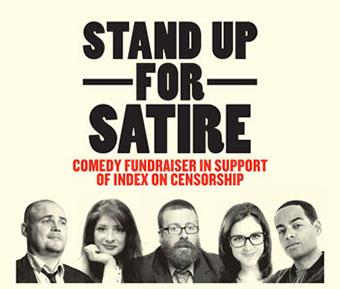 Index on Censorship has been publishing articles on satire by writers across the globe throughout its 43-year history. Prior to our event, Stand Up for Satire, we published a series of archival posts from the magazine on satire and its connection with freedom of expression.
Index on Censorship has been publishing articles on satire by writers across the globe throughout its 43-year history. Prior to our event, Stand Up for Satire, we published a series of archival posts from the magazine on satire and its connection with freedom of expression.
14 July: The power of satirical comedy in Zimbabwe by Samm Farai Monro | 17 July: How to Win Friends and Influence an Election by Rowan Atkinson | 21 July: Comfort Zones by Scott Capurro | 24 July: They shoot comedians by Jamie Garzon | 28 July: Comedy is everywhere by Milan Kundera



